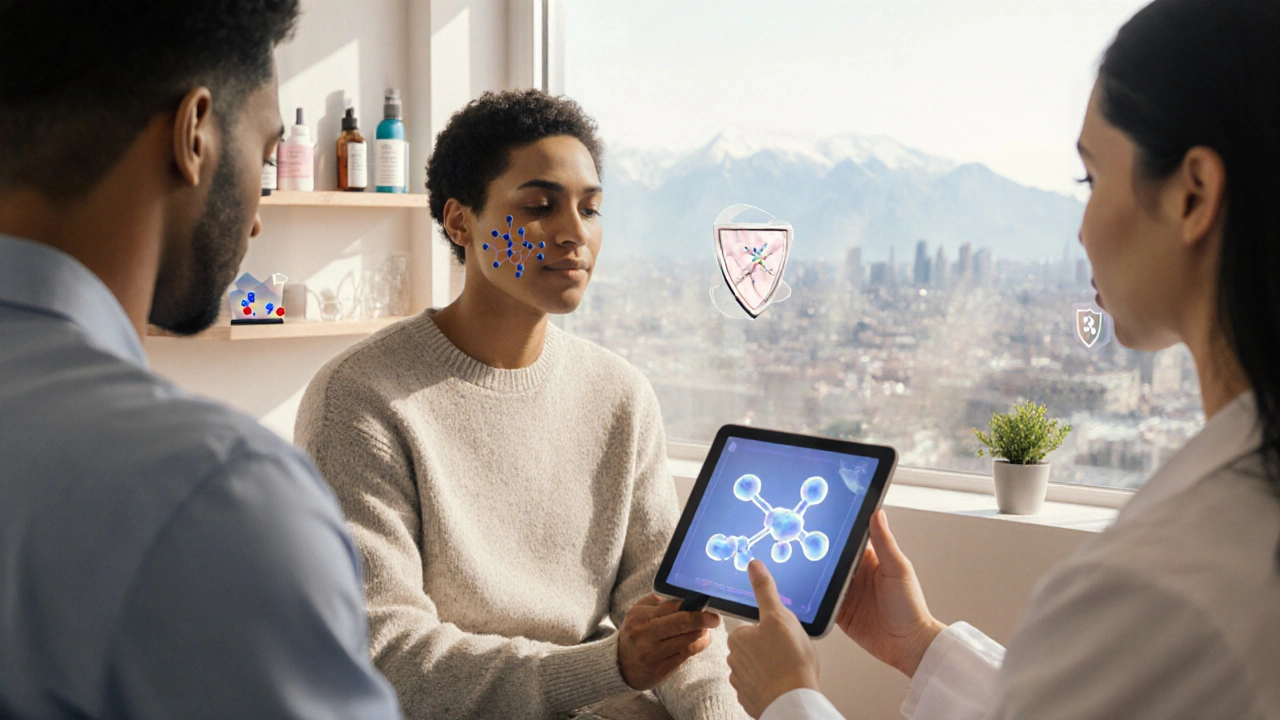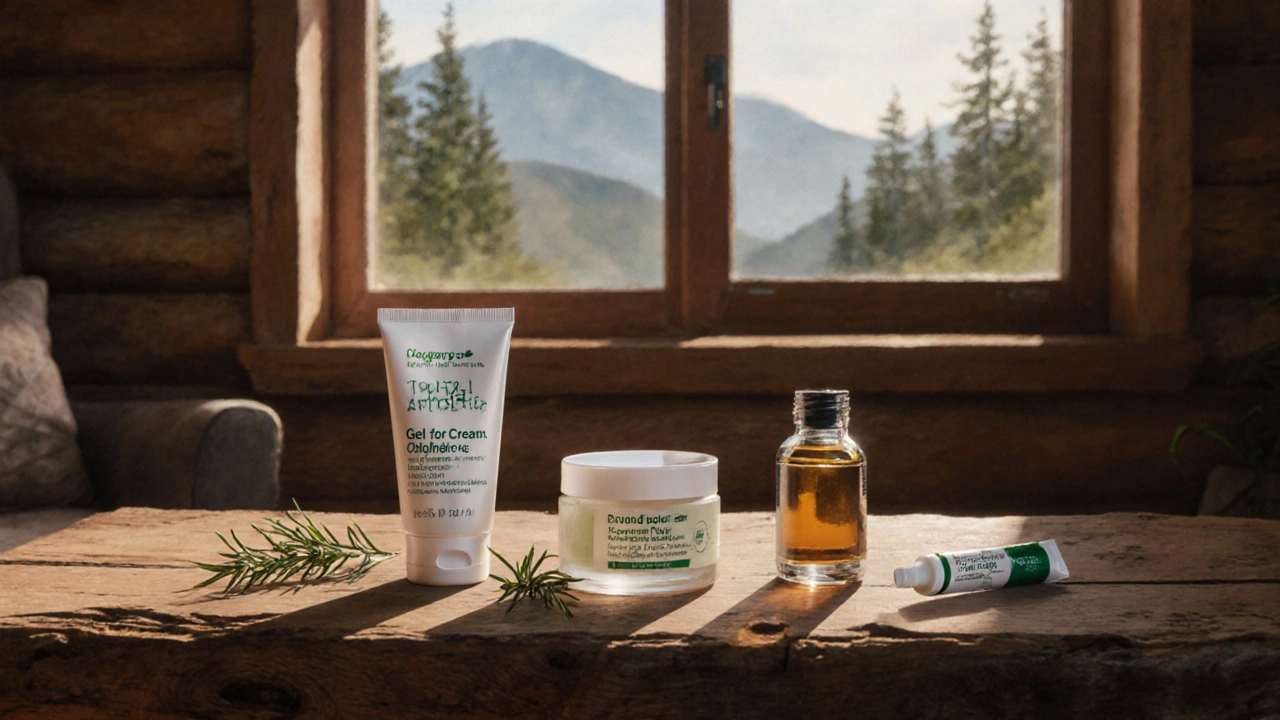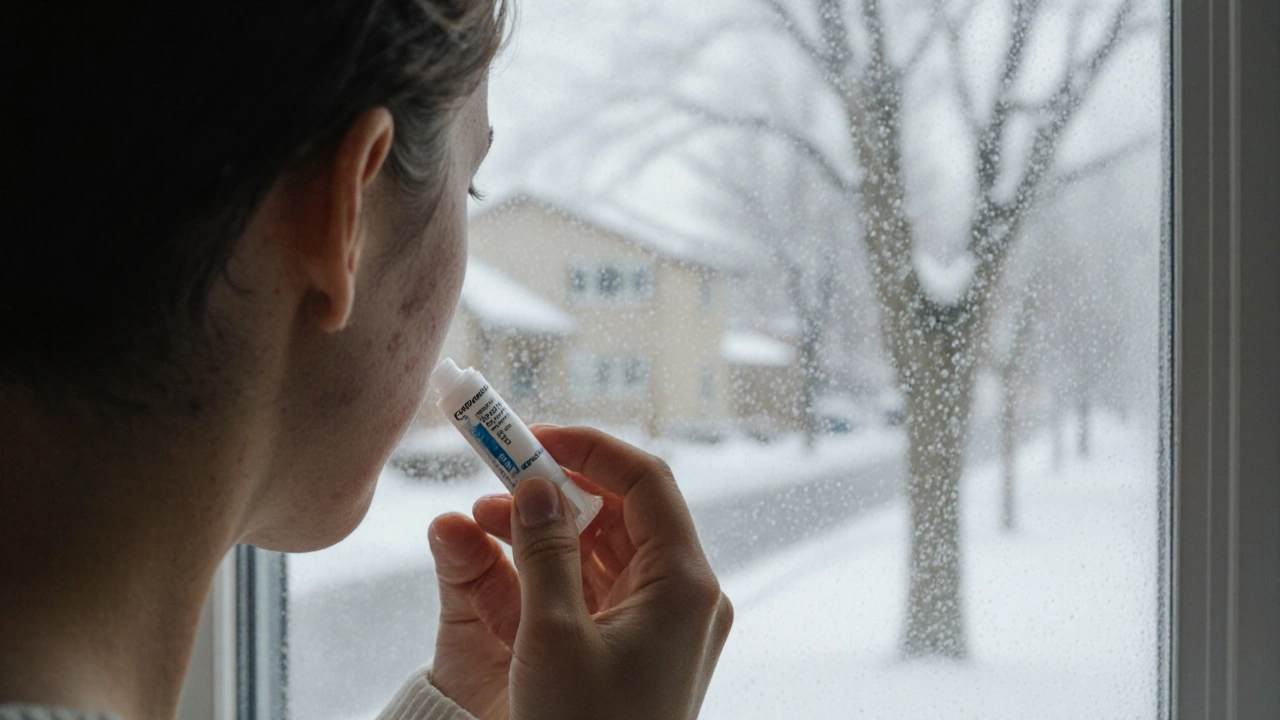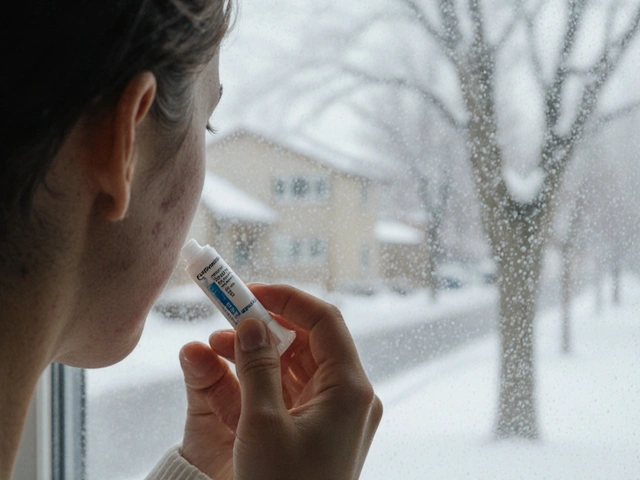Topical Antibiotic Selector
Select your symptoms and preferences to find the most suitable topical antibiotic.
Cleocin Gel is a topical formulation of clindamycin phosphate (1%) that treats inflammatory acne and certain bacterial skin infections. It works by inhibiting bacterial protein synthesis, targeting Propionibacterium acnes and Staphylococcus aureus. In Australia, it’s prescription‑only and typically applied twice daily.
TL;DR - Quick Takeaways
- Cleocin Gel is effective for mild‑to‑moderate acne but can trigger antibiotic resistance.
- Topical alternatives like mupirocin or fusidic acid excel for impetigo and infected cuts.
- Non‑antibiotic options (e.g., benzoyl peroxide, tea tree oil) reduce resistance risk.
- Oral agents such as doxycycline are reserved for severe or resistant cases.
- Choose based on infection type, resistance patterns, and skin tolerance.
How Cleocin Gel Works and When to Use It
The active ingredient, clindamycin, binds to the 50S ribosomal subunit of bacteria, stopping peptide chain formation. This bacteriostatic action reduces the load of acne‑causing microbes and dampens the inflammatory cascade that leads to papules and pustules. Because it’s a gel, the drug stays on the epidermis, limiting systemic absorption.
Typical indications include:
- Inflammatory facial acne (comedones, papules, pustules).
- Secondary bacterial infection of eczema or dermatitis.
- Adjunct therapy with benzoyl peroxide to curb resistance.
Patients with a history of Clostridioides difficile infection or known hypersensitivity should avoid clindamycin.
Key Attributes of Cleocin Gel
| Attribute | Detail |
|---|---|
| Active ingredient | Clindamycin phosphate 1% |
| Formulation | Clear, water‑based gel |
| Prescription status (AU) | Schedule 4 (prescription only) |
| Typical dosing | Apply to clean, dry skin twice daily |
| Common side effects | Dryness, mild burning, rare contact dermatitis |
| Resistance concerns | High when used as monotherapy > 12 weeks |
Topical Antibiotic Alternatives
When deciding whether to stick with Cleocin Gel or switch, it helps to understand the main competitors. Below are the most frequently prescribed topical antibiotics for skin conditions.
Bactroban is a mupirocin calcium ointment (2%) that targets Gram‑positive bacteria, especially Staphylococcus aureus, including MRSA strains. It’s the go‑to for impetigo, small abrasions, and infected eczema.
Fucidin contains fusidic acid (2%) and is effective against staphylococcal skin infections, particularly in children.
Metrogel is a metronidazole gel (0.75%‑1%) used mainly for rosacea‑related papules and pustules, offering anti‑inflammatory benefits without classic antibiotic resistance worries.
Altabax delivers retapamulin ointment (1%), a pleuromutilin antibiotic approved for uncomplicated skin infections like impetigo. It has a low cross‑resistance profile.
Non‑antibiotic options such as benzoyl peroxide (5‑10% cream or gel) work by oxidising bacterial proteins, making them a solid partner or alternative for acne without fostering resistance.
Natural topical agents like tea tree oil (5‑10% dilution) show modest antibacterial activity and are popular for mild breakouts, though evidence is less robust than prescription drugs.

Side‑by‑Side Comparison
| Feature | Cleocin Gel | Bactroban | Fucidin | Metrogel | Altabax |
|---|---|---|---|---|---|
| Primary indication | Acne, minor bacterial skin infection | Impetigo, infected cuts | Staph infections, especially in kids | Rosacea‑related papules | Uncomplicated impetigo, small lesions |
| Formulation | Gel (1%) | Ointment (2%) | Ointment (2%) | Gel (0.75%‑1%) | Ointment (1%) |
| Prescription requirement (AU) | Yes | Yes | Yes | Yes | Yes |
| Typical treatment length | 4‑12 weeks | 5‑10 days | 5‑10 days | 4‑12 weeks (maintenance) | 5‑10 days |
| Resistance risk | Moderate‑high if monotherapy >12wks | Low‑moderate | Low‑moderate | Very low (anti‑inflammatory) | Low (novel class) |
| Common side effects | Dryness, mild burning | Local irritation, itching | Contact dermatitis | Transient stinging, dryness | Skin irritation, rare hypersensitivity |
Choosing the Right Option for Your Skin
Think of the decision as a simple flow:
- Identify the condition: acne vs. impetigo vs. rosacea.
- Check for past antibiotic exposure or known resistance.
- Assess tolerance: oily skin often prefers gels; dry or cracked skin may do better with ointments.
- Consider adjuncts: pairing Cleocin Gel with benzoyl peroxide reduces resistance dramatically.
- If you need a non‑antibiotic route, switch to retinoids or salicylic acid for acne, or use azelaic acid for rosacea.
For teenage acne that’s worsening after 8 weeks of clindamycin alone, a step‑up to oral doxycycline (100mg daily) is common practice, while preserving topical antibiotics for short‑term flares.
Practical Tips & Cautions
- Apply to clean skin; wait 10‑15 minutes after washing to let the barrier close.
- Never use more than prescribed; excess doesn’t speed results but raises resistance.
- If you experience severe redness, blistering, or spreading infection, stop the product and see a pharmacist or GP.
- Pregnant or breastfeeding women should discuss clindamycin safety; most data suggest low systemic exposure, but a risk‑benefit conversation is essential.
- Store in a cool, dry place; gel can lose potency above 30°C.
Related Concepts and Wider Context
Understanding the landscape helps you avoid pitfalls. Antibiotic resistance is the genetic adaptation of bacteria after repeated exposure to the same drug class. With topical agents, resistance tends to stay localized but can spread to systemic infections.
The skin microbiome houses both harmful and beneficial microbes. Over‑use of broad‑spectrum antibiotics like clindamycin can disrupt this balance, potentially worsening acne via overgrowth of resistant strains.
Strategies to protect the microbiome include rotating topical antibiotics, using non‑antibiotic anti‑inflammatories, and incorporating probiotic skin care products.
Next Steps for Readers
If you’ve been on Cleocin Gel for a few weeks and aren’t seeing improvement, consider these actions:
- Schedule a visit with your dermatologist to discuss a combo therapy (e.g., benzoyl peroxide + clindamycin).
- Ask about a short course of mupirocin if you have a concurrent impetigo‑type lesion.
- Trial a 5% benzoyl peroxide gel on alternate nights to reduce bacterial load.
- Review your skincare routine for occlusive products that might trap bacteria.
Remember, the best treatment is the one that clears lesions, feels comfortable, and preserves your skin’s natural defenses.

Frequently Asked Questions
Can I use Cleocin Gel and benzoyl peroxide together?
Yes. Applying benzoyl peroxide in the morning and clindamycin gel at night is a proven combo that cuts resistance risk and boosts acne clearance.
How long should I stay on Cleocin Gel before switching?
Most dermatologists recommend a 12‑week maximum. If there’s no improvement after 8 weeks, a review is warranted to consider alternatives or adjuncts.
Is clindamycin gel safe during pregnancy?
Systemic exposure from the gel is minimal, and many clinicians deem it low‑risk, but always discuss with your OB‑GYN before starting any medication.
What’s the difference between Bactroban and Fucidin?
Bactroban (mupirocin) covers a broader range, including MRSA, while Fucidin (fusidic acid) is mainly active against non‑MRSA Staphylococcus. Their formulations differ-ointment vs. cream-affecting patient comfort.
Can I switch from Cleocin Gel to a natural remedy?
If your acne is mild and you’ve completed a short course of clindamycin, you can transition to tea tree oil or zinc‑pyrithione washes. Keep expectations realistic-natural options work slower.
Why does my skin feel oily after using Cleocin Gel?
Clindamycin itself isn’t oily, but the gel base can trap sebum. Pair it with a lightweight, non‑comedogenic moisturizer to balance hydration.


Cleocin Gel (Clindamycin) is a staple in the acne arsenal, and here’s why it works so well 😊. The 1% clindamycin phosphate penetrates the follicular microenvironment, shutting down P. acnes protein synthesis. Because it’s a gel, systemic absorption stays negligible, which is why dermatologists consider it safe for long‑term use. However, the biggest pitfall is bacterial resistance, especially after 12 weeks of monotherapy. Pairing it with benzoyl peroxide every morning dramatically cuts that risk and speeds up lesion clearance. 🌟
From a pharmacodynamic standpoint, the clindamycin‑benzoyl peroxide conjugate exhibits a synergistic bacteriostatic–oxidative cascade, effectively attenuating the selection pressure for mecA‑mediated resistance phenotypes. Nonetheless, the clinical efficacy plateau observed beyond the 8‑week threshold underscores the diminishing marginal utility of protracted monotherapy. One must also consider the dermal microbiome perturbation index, which escalates concomitantly with repeated lipophilic occlusion. In short, the protocol is theoretically sound but operationally suboptimal without rigorous adherence to antimicrobial stewardship guidelines.
Yo, anyone still slapping clindamycin on their face like it’s a magic wand? It’s okay for a quick fix, but if you’re not rotating it with something else you’ll just feed the resistant bugs.
Oh wow, because nothing screams ‘clear skin’ like a gel that makes you feel like a desert 🌵. If you love the thrill of watching your pores dry out, keep going – it’s practically a spa treatment for your face. 😏 But hey, at least you’ll have a great excuse to buy that pricey moisturizer, right? 💁♀️
I remember the first time I tried Cleocin Gel – my skin felt like a battlefield, each breakout a tiny explosion 💥! The dryness was relentless, turning my cheeks into a desert 🌞, yet the hope of clearer skin kept me going. By week six, tiny miracles appeared: a few pimples vanished like snowflakes melting in spring. The relief was almost cinematic, as if the sun finally broke through a stormy sky 🌤️. Still, the lingering itch reminded me that every hero's journey has its price.
From a therapeutic perspective, integrating Cleocin Gel with a benzoyl peroxide regimen aligns with evidence‑based antimicrobial stewardship principles. The combination leverages clindamycin’s protein synthesis inhibition while the peroxide provides a rapid oxidative kill, reducing the selective pressure for resistant strains. Patients should be counseled on proper application intervals to minimize cutaneous irritation, especially those with xerotic skin types. Moreover, monitoring for signs of contact dermatitis remains essential during the initial treatment phase.
Cleocin Gel can be a useful part of an acne treatment plan when used correctly. It’s important to follow the dermatologist’s instructions and keep the skin clean. If you notice excessive dryness, adding a gentle moisturizer can help. Staying consistent with the regimen usually leads to gradual improvement over several weeks.
Exactly, Bryce. Consistency is key, and pairing the gel with a non‑comedogenic moisturizer can mitigate dryness without compromising efficacy. Also, remind patients to apply the gel to a freshly cleansed surface and allow it to absorb before layering other products. This simple routine often enhances both tolerability and outcomes. 😊
In the grand theatre of skin care, every gel is but a fleeting whisper before the curtain falls.
When evaluating Cleocin Gel within a comprehensive acne management protocol, several pivotal considerations emerge. First, the pharmacodynamics of clindamycin phosphate at a 1% concentration provide a targeted bacteriostatic effect against Propionibacterium acnes, which remains a cornerstone of inflammatory lesion pathogenesis. Second, the vehicle- a water‑based gel-optimizes epidermal delivery while minimizing systemic exposure, an attribute that is particularly advantageous for patients with comorbidities that contraindicate oral antibiotics.
Nonetheless, the risk of resistance escalation cannot be understated. Literature indicates that monotherapy extending beyond twelve weeks markedly increases the prevalence of clindamycin‑resistant strains, a phenomenon that may compromise future therapeutic options. Accordingly, best practice guidelines advocate for adjunctive therapy, most commonly benzoyl peroxide, which exerts a rapid oxidative bactericidal action and mitigates resistance selection pressure.
From a tolerability perspective, adverse events are generally mild, encompassing xerosis, transient erythema, and occasional contact dermatitis. Patients with inherently dry or barrier‑compromised skin should be counseled to employ a compatible, non‑comedogenic moisturizer to preserve barrier integrity.
In terms of clinical outcomes, a systematic review of randomized controlled trials reports an average reduction of 30–45% in inflammatory lesion count after eight weeks of combined clindamycin‑benzoyl peroxide therapy, compared with a modest 15–20% reduction with clindamycin monotherapy.
It is also prudent to consider patient-specific factors such as skin type, acne severity, and prior treatment history. For instance, individuals with oily skin may experience enhanced absorption of the gel, whereas those with sensitive or atopic dermatoses might be predisposed to irritant reactions.
Finally, ongoing monitoring is essential. Clinicians should reassess treatment efficacy and side‑effect profile at regular intervals-typically every four to six weeks-to determine whether to continue, augment, or discontinue therapy. Transitioning to alternative modalities, such as topical retinoids, azelaic acid, or oral agents like doxycycline, may be warranted in cases of suboptimal response.
In summary, Cleocin Gel remains an effective component of the acne armamentarium when employed judiciously, in combination with benzoyl peroxide, and with vigilant attention to resistance patterns, tolerability, and patient‑centred outcomes.
While the article enumerates the pros of clindamycin gel, it glosses over the pharmacokinetic limitations inherent to topical formulations. The relatively low cutaneous bioavailability translates to suboptimal concentration in deeper follicular structures, which may compromise eradication of resilient P. acnes strains. Moreover, the resistance data cited are outdated, predating the surge of macrolide‑lincosamide cross‑resistance observed in recent epidemiological surveys. The recommendation to pair with benzoyl peroxide, although sound, lacks nuance regarding irritancy thresholds in sensitive dermatoses. Overall, the piece would benefit from a more rigorous analysis of microbiome disruption and long‑term stewardship implications.